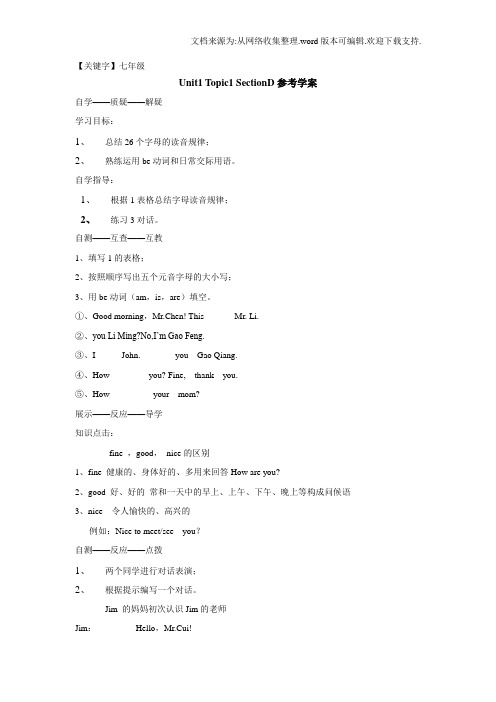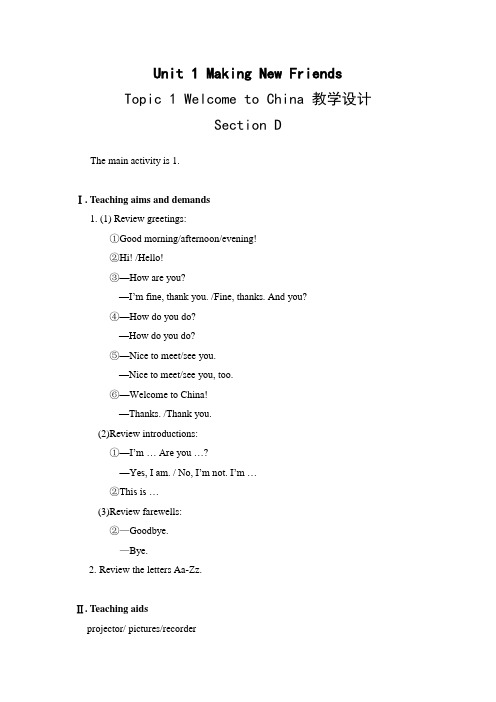仁爱版七年级英语上册Unit1Topic1SectionD教案
- 格式:doc
- 大小:323.00 KB
- 文档页数:7

仁爱版七年级上英语教案unit1topic1SectionDSection DThe main activities are 1 and 5. 本课重点活动是1和5。
Ⅰ. T eaching aims and demands 教学目标1. (1)Review greetings:①Good morning/afternoon/evening!②Hi!/Hello!③—How are you?—I’m fine, thank you./Fine, thanks. And you?④—How do you do?—How do you do?⑤—Nice to meet/see you.—Nice to meet/see you, too.⑥—Welcome to China!—Thanks./Thank you.(2)Review introductions:①—I’m … Are you …?—Y es, I am. / No, I’m not. I’m …②This is …(3)Review farewells:①—See you later.—See you.②—Goodbye.—Bye.2. Review the letters Aa-Zz.Ⅱ. T eaching aids 教具教学挂图/小黑板/字母卡片/录音机Ⅲ. Five-finger T eaching Plan 五指教学方案Step 1 Review 第一步复习(时间:8分钟)通过复习上节课所学功能用语,创设情境导入新课。
1. (师生互动和生生互动复习上节课所学问候语及告别语,巩固问候语及告别语的英文表达法。
)T: Let’s review greetings and farewells.T: Hi, class!(教师作挥手打招呼状。
)Ss: Hi, Mr. …/Miss …T: Nice to meet/see you.(教师作握手状。

【关键字】七年级Unit1 Topic1 SectionD参考学案自学——质疑——解疑学习目标:1、总结26个字母的读音规律;2、熟练运用be动词和日常交际用语。
自学指导:1、根据1表格总结字母读音规律;2、练习3对话。
自测——互查——互教1、填写1的表格;2、按照顺序写出五个元音字母的大小写;3、用be动词(am,is,are)填空。
①、Good morning,Mr.Chen! This Mr. Li.②、you Li Ming?No,I’m Gao Feng.③、I John. you Gao Qiang.④、How you? Fine, thank you.⑤、How your mom?展示——反应——导学知识点击:fine ,good,nice的区别1、fine 健康的、身体好的、多用来回答How are you?2、good 好、好的常和一天中的早上、上午、下午、晚上等构成问候语3、nice 令人愉快的、高兴的例如:Nice to meet/see you?自测——反应——点拨1、两个同学进行对话表演;2、根据提示编写一个对话。
Jim 的妈妈初次认识Jim的老师Jim:Hello,Mr.Cui!Mr.Cui:Jim:,Mom:Mr.Cui:自测——反应——点拨1、请写出26个英文字母的大小写:2、交际用语练习(每空一词)A: Good afternoon,Li Gang?B: Good afternoon,Zhao Qi! How you?A: I’m fine,thank you. Nice to see you ?B: Nice to see you, ?A: Hi, Li Gang! This Bill!B: do you do,Bill?C: How do you do?B: Welcome to !C: you.A: Hello! Are you Yang Chao?D: Yes,I .A: you later.D: See you.回顾——总结——反思此文档是由网络收集并进行重新排版整理.word可编辑版本!。



精心整理Unit1Topic1SectionA学习目标:1、从Aa-Gg的书写2、交际英语合作交流:1、Goodmorming.早上好。
此句为正式问候语,用于早晨至中午12点以前。
它的答语仍然用Goodmorming.2、Hi!喂!你好!Hello!也是“喂!你好!”的意思。
hi和hello英语中使用频率最高的日常用语之一,多用于同学、同时、熟人以及朋友之间相互打招呼,语气比较随便,意为“你好”。
3、—AreyouMichael?你是迈克尔吗?—Yes,Iam.是的,我是。
Areyou··年龄等问题,回答肯定的用Yes,4、—WelcometoChina!欢迎到中国来!—Thankyou!谢谢。
welcometo+地点名词欢迎到······来。
习题巩固:Ⅰ、按照四线格要求写出Aa-Gg。
Ⅱ、单项选择。
()1、—youLiPing?—Yes,I.A.Are;amB.I;()2、——A.Fine,thankyou.B.Thankyou()3、——A.Yes,I’m.()4、——A.Maria,hi.B.Kangkang,hi.C.Goodmorning.D.Hi,Michael.()5、——Thanks.A.Nicetomeetyou.B.Goodmorning.C.Yes,Iam.D.WelcometoBeijingRen’aiInternational(国际的)School!Ⅲ、从Ⅱ栏选出对应的答语。
ⅠⅡ()1.Goodmorning.A.Fine,thanks.()2.Hello!B.Nicetomeetyou,too.()3.Nicetomeetyou.C.No,Iamnot.()4.IamKangkang.AreyouMaria?D.Goodmorning.()5.Howareyou?E.Hi,Mr.Zhang.Unit1Topic1,SectionB 学习目标:1.字母的书写。

Unit 1 Making New Friends Topic 1 Welcome to China 教学设计Section DThe main activity is 1.Ⅰ. Teaching aims and demands1. (1) Review greetings:①Good morning/afternoon/evening!②Hi! /Hello!③—How are you?—I’m fine, thank you. /Fine, thanks. And you?④—How do you do?—How do you do?⑤—Nice to meet/see you.—Nice to meet/see you, too.⑥—Welcome to China!—Thanks. /Thank you.(2)Review introductions:①—I’m … Are you …?—Yes, I am. / No, I’m not. I’m …②This is …(3)Review farewells:②—Goodbye.—Bye.2.Review the letters Aa-Zz.Ⅱ. Teaching aidsprojector/ pictures/recorderⅢ. Teaching proceduresStep 1 Revision of greetings1. Review the greetings and farewells interactively between T and Ss.2. Show the boxes of grammar and functions.3. Complete 1, review all the letters and classify the lettersListen and fill in the blanks in 1, then find the same sound in each line.Step 2 Revision of LettersClassify all the letters according the sound1. Review Aa-Zz.2. Find out the letters with the same vowel phoneme.T leads Ss to find out the regularities of pronunciation. Pay attention to Oo and Rr which are single3. Get Ss to know about the picture in 1, play the recorder and complete 1.4. Draw Ss’attention to the acronyms and make them to say more. Then play the recorder and have the Ss repeat.Step 3 Presentation (complete 3)1. Utilize pictures and pave the way for the following listening exercise.2. Get Ss to number all the pictures.3. Check the answer and have Ss listen the recorder again.4. Ask them to finish all the blanks, and check the answers.5. Get them to practice in pairs and invite some pairs to act it out after a few minutes. Step 4 Consolidation1. Use PPT to show the box of grammar and get Ss to observe and conclude the usage of Be form.Make similar sentence with Be.2. Review some useful expressions.Have them practice in pairsStep 5 Homework:(1) Dictate all the letters.(2) Design a dialog relating to greeting and farewell.。
仁爱版英语七年级上册_仁爱版七年级英语上册unit1教案Unit1 Making New FriendsTopic 1 Section D一学习目标1 复习26个字母2 复习所学问候交际语言①Hi! Hello!②Good morning. / Good afternoon. ③How are you? / Fine,thank you. ④How do you do? / How do you do?⑥I’m ...Are you ...? Yes, I am. ⑦See you later. See you. ⑧Good-bye. Bye-bye.3 了解并记住五个元音字母,并根据其读音把26个字母分类。
4 be动词的用法和与主语的缩写形式。
二学习重点 : 本课重点活动是1,2和4。
三学习难点: 26个字母的书写规则、读音和 B e( am, is are ) 动词的用法四学习过程(一) 复习导入按顺序和正确的格式书写26个字母补全下列对话1. A:Good morning,Mr.Chen2. A.How are you ? . B: ,3. A: Good afternoon4. A: Nice to see you . .5. A: Are you Jane ? B: Yes, .6 A: Hello, Mr. Lee7 teacher, B: Mr. Li , this is my mother.8A: How do you do? B: ?(二 )自学指导( 1 )本节课主要是复习以前所学内容,看课文第八页4a部分,语法聚焦,这部分主要学习Be动词的简单用法和其于主语的缩写形式。
要牢牢掌握。
( 2 ) 制作自己的名字卡片,指导在英语中人名字的表达和书写格式。
( 3 ) 5 个元音字母:Aa Ee Ii Oo Uu( 4 ) 掌握读音/ei/ /i:/ /ai/ / / /ju:/ 并试着把26个字母按读音进行分类(三) 问题导学1. 26 个字母可以分为几类?2. 同学们会把下列汉语翻译成英语吗?早上好_______________ 下午好 ____________________你好 __________________ 你身体好吗?______________________ 我身体好,谢谢,你呢?_______________________________________你是康康吗?__________ 是的,我是。
Topic 1 Welcome to China. 教学设计主备人:夏丽红一、教学内容及分析1.内容:本课的内容是简单的英语问候表达方式以及能正确拼读和书写26个英文字母A到Z的学习,指的是会用Hello, Hi, Good morning,Good evening, Good afternoon,How are you? I'm fine, thanks.Welcome to..., How do you do?来和别人打招呼;能熟练的说出大写字母A到Z所对应的小写字母,能清晰的知道其大小写字母在四线三格上的规范书写及发音标准;其关键是区别这几种问候方式的不同用法并通过活动熟练掌握,另外还要会认读和书写26个英文字母。
理解它的关键就要鼓励学生大胆说和写英语,并从一开始就规范学生的发音和书写。
2.分析:学生在小学已经学过英文字母的读写,具有了学习本课知识的认知前提。
在此基础上,接着学习正确使用交际问候语,那么教学重点就是字母的读写,问候的口语交际,解决重点的关键是创设情境,在听说读写的活动中习得交际问候语,并让学生了解大小写字母的用法区别和中英姓名表示的区别。
二.教学目标及分析1.目标定位:掌握和理解单元的核心问候语;熟练掌握英文字母A到Z的拼读和书写。
了解大小写的区别和中英姓名表示的不同。
2.目标解析:掌握问候语就是指掌握Hello, Good morning,Good evening, Good afternoon,How do you do?How are you? I’m fine, thanks等问候表达方式并且区分好各种问候的回答。
掌握字母A到Z的拼读和书写就是指A到Z英文字母的大小写形式及所占的四线三格的位置并规范书写。
了解大小写的区别和中英姓名表示的不同就是指句首专有名词要大写,其他小写;中文姓前名后,英文名前姓后。
三、问题诊断与分析在本单元的教学中,学生可能遇到的问题是发音不准和书写不规范,产生这一问题的原因是因为学生对英语的语音特点还不够了解,书写操练还不够多。
Unit1 Topic2 SectionD 参考教案Ⅰ. Material analysis本节课是一节复习课,主要活动是grammar, functions 及数字的应用。
Grammar部分通过练习的方式引导学生总结主格人称代词的用法。
be动词is, are和疑问代词what/who/where引导的疑问句及缩略形式。
Functions 部分通过引导学生复习Sections A~C,总结本话题所学的询问姓名、电话号码和国籍等功能的表达法。
另外,通过综合练习活动,拓展学生的知识面,巩固数字、询问姓名和国籍等基本情况的表达。
最后,老师通过Project 活动让学生根据要求完成自己的名片设计,培养学生灵活运用所学语言的能力。
Ⅱ. Teaching aims1. Knowledge aims引导学生自主总结be动词am, is, are的一般现在时在不同情况下形式上的变化及缩写形式I’m = I am, they’re = they are, what’s = what is, aren’t = are not, isn’t = is not;引导学生复习用英语表达询问姓名、国籍、电话号码的方式:What’s your name? Where are you from? What’s your telephone number?引导学生总结本话题特殊疑问词what, where, who引导的特殊疑问句及缩写形式。
2. Skill aims能听懂有关询问姓名、国籍、电话号码等基本情况的简单对话或叙述;能运用图文就表示询问姓名、国籍、电话号码等的基本情况的话题进行简单的交流;能正确地朗读对话,并能注意语音语调;能根据已学音标尝试拼读单词;能够初步了解元音字母a, e及辅音字母p, b, t, d, k, g的读音规则。
⒊ Emotional aims能够与同学积极合作,参与课堂活动,大胆实践,培养友好互助的精神;能有兴趣用所学的功能句进行口头对话;使学生乐于接触并了解异国文化。
Unit 1 Making New FriendsTopic 1 Welcome to China!Section DThe main activities are 1 and 5. 本课重点活动是1和5。
Ⅰ. Teaching aims and demands 教学目标1. (1)Review greetings:①Good morning/afternoon/evening!②Hi!/Hello!③—How are you?—I’m fine, thank you./Fine, thanks. And you?④—How do you do?—How do you do?⑤—Nice to meet/see you.—Nice to meet/see you, too.⑥—Welcome to China!—Thanks./Thank you.(2)Review introductions:①—I’m … Are you …?—Yes, I am. / No, I’m not. I’m …②This is …(3)Review farewells:①—See you later.—See you.②—Goodbye.—Bye.2. Review the letters Aa-Zz.Ⅱ. Teaching aids 教具教学挂图/小黑板/字母卡片/录音机Ⅲ. Five-finger Teaching Plan 五指教学方案Step 1 Review 第一步复习(时间:8分钟)通过复习上节课所学功能用语,创设情境导入新课。
1. (师生互动和生生互动复习上节课所学问候语及告别语,巩固问候语及告别语的英文表达法。
) T: Let’s review greetings and farewells.T: Hi, class!(教师作挥手打招呼状。
)Ss: Hi, Mr. …/Miss …T: Nice to meet/see you.(教师作握手状。
)Ss: Nice to meet/see you, too.T: How are you?Ss: I’m fine, thank you.T: See you later./Goodbye.(教师作挥手告别状。
)Ss: See you./Bye.(让学生两人一组练习问候语和告别语。
)2. (教师出示2中的挂图,让学生观察这几幅图中的情境,并根据情境两人一组做对话练习。
)T: Look at the pictures. Find out how Kangkang greets his teacher, Miss Wang. Then practice the dialog in pairs.S1: How are you?S2: I’m fine, thanks.…Step 2 Presentation 第二步呈现(时间:8分钟)利用2中图片,设置情境,练习对话并表演,让学生熟练运用本课涉及问候和告别的功能用语。
1. (让学生听2录音,完成排序。
)T: Please listen and number the pictures in 2.2. (根据书上的这几幅图,先师生后生生进行对话操练。
练习2。
)T: Let’s make a conversation and perform it.S1: Good morning, Miss Wang!T: Good morning, Kangkang!S1: How are you?T: Fine, thanks.S1: Nice to see you.T: Nice to see you, too.S1: Goodbye, Miss Wang.T: Bye.(让学生两人一组练习2中的对话。
)3. (两人一组表演这个对话,对表演得非常流畅的学生给予掌声鼓励。
)(这是本话题的目标语言,正常情况下要求学生独立完成表演。
如果学生不能流畅地表演,教师要给予适当指导。
)Step 3 Consolidation 第三步巩固(时间:12分钟)复习归纳本话题主要语法和功能用语,设置“名人会”情景进行对话,培养学生运用所学语言的能力,激发他们的学习兴趣。
1. (利用小黑板出示语法重点里的句子,让学生观察并总结be动词用法。
)I’m Kangkang. I’m=I amAre you Maria? Yes, I am./No, I’m not.Miss Wang, this is Michael.2. (小组竞赛。
让学生四人一组找出本话题有用的表达,在规定时间内,哪组找得最快最准确,哪组获胜。
评出优胜组。
完成4b。
)Good morning/afternoon/evening! Good morning/afternoon/evening!Welcome to China! Thanks./Thank you.Hello!/Hi! Hello!/Hi!Nice to meet/see you. Nice to meet/see you, too.How do you do? How do you do?How are you ? I’m fine, thank you./Fine, thanks.Goodbye. Bye.See you later. See you.(让学生分组练习这些有用表达,并要求掌握。
)3. (让学生各自模仿一位“名人”,进行一次“名人会”。
会上“名人”互相介绍认识,复习本话题的主要功能用语和语法句。
)T: Now suppose you all are the famous persons, use your new names to introduce yourselves, get to know others, and make an introduction to your friends. For example:S1: Hello, I’m Zhou Yu. Are you Zhuge Liang(诸葛亮)?S2: Yes, I am. Nice to meet you.S1: Nice to meet you, too.S2: Hi, Liu Bei. How are you?S3: I’m fine. Thank you. And you?S2: I’m OK. Zhou Yu, this is my friend Liu Bei. Liu Bei, this is Zhou Yu.S3: How do you do?S1: How do you do?(小组活动。
三人一组,限定时间,在规定时间内能够完成表演的组合,给予掌声鼓励。
)Step 4 Practice 第四步练习(时间:10分钟)复习26个字母,并按发音进行分类,培养学生的归纳能力和合作精神。
1. (复习字母Aa-Zz。
)T: Let’s recite English letters together. OK?Ss: OK.T: One, two, three, go!Ss: Aa Bb Cc…Zz2. (让学生将字母按相同音素分类。
教师板书归类后的字母,并要求掌握。
)Aa Hh Jj KkEe Bb Cc Dd Gg Pp Tt Vv ZzIi YyFf Ll Mm Nn Ss XxUu Qq WwOoRr(教师引导学生找出这些字母之间潜在的发音规律。
注意Oo和Rr是单个的。
)3. (教师先让学生理解教材1中的图片,然后播放录音,完成1。
)T: Listen to the tape and finish 1.4. (让学生看3中的缩写词,尽可能多地说出中文意思,说不出的教师补充。
播放3的录音,学生跟读。
让学生小组讨论他们还知道哪些缩写词,和同学一起分享。
)Step 5 Project 第五步综合探究活动(时间:7分钟)通过游戏和制作名片进行操练,复习巩固本话题所学要点,培养学生综合运用所学语言的能力和合作精神。
1. (组织学生做下列字母游戏,检查学生对字母的掌握情况。
)T: Let’s play a game with the English letter cards.(1)拿出字母卡片,大写一套,小写一套,男女学生各派一名代表上讲台,教师给男生大写字母卡片,给女生小写字母卡片,然后发出下列号令,最先完成的为获胜者,另一方应为获胜者鼓掌。
本游戏男女生可轮换进行,每轮评比一次。
①把字母表中的五个元音字母按顺序贴在黑板上。
②把字母表中的第十二,十三个字母贴在黑板上。
③把Gg和Qq两个字母后面的第三个字母贴在黑板上。
(2)拿出字母卡片,按发音规律给二十六个字母归类。
男女学生各两名,黑板中间画竖线,一分为二,男左女右。
教师做出如下提示:①// ②// ③// ④// ⑤// ⑥Don’t forget // and //。
学生按教师的提示把手中的字母按顺序贴在黑板上,最先完成的为获胜者。
2. (教会学生制作各自名字的名片,完成5。
)T: Let’s learn how to make your own name cards.(1)教学生动手做名片,有英文名字的写英文名字,没有英文名字的写自己姓名的汉语拼音。
(2)学生拿着名片在同学间穿梭,交朋友,互换名片。
(3)学生把所交换的名片按字母顺序排列。
(4)学生把所交换的名片分成两组:男生名字和女生名字。
(5)教师画简笔画,让学生模仿此情景,进行对话,一边握手,一边交换名片,用所复习的句型设计对话内容。
可三人一组进行操练。
T: Act out a conversation according to the information on your card.Example:S1=Kangkang S2=Jane S3=Li MingS1: Hello! I’m Kangkang. Are you Jane?S2: Yes, I am.S1: Nice to meet you.S2: Nice to meet you, too.S1: Hi! Li Ming. This is Jane. Jane, this is Li Ming.S2: How do you do?S3: How do you do?S1& S3: Welcome to China!S2: Thank you.S1& S3: Goodbye, Jane.S2: Bye.3. Homework:(1)默写26个英文字母(大小写)。
(2)设计一个问候和告别的对话。
(3)让学生自带照片,以备下节课使用。
Welcome to China!Section D1.Aa Hh Jj Kk 3.Miss Wang, this is Michael.Ee Bb Cc Dd Gg Pp Tt Vv Zz 4.—Good morning/afternoon!Ii Yy —Good morning/afternoon!Ff Ll Mm Nn Ss Xx 5.—Nice to meet/see you.Uu Qq Ww —Nice to meet/see you, too.Oo 6.—How are you?Rr —I’m fine, thank you./ Fine, thanks.2.—Are you Maria? 7.—See you later.—Yes, I am./No, I’m not. —See you.。